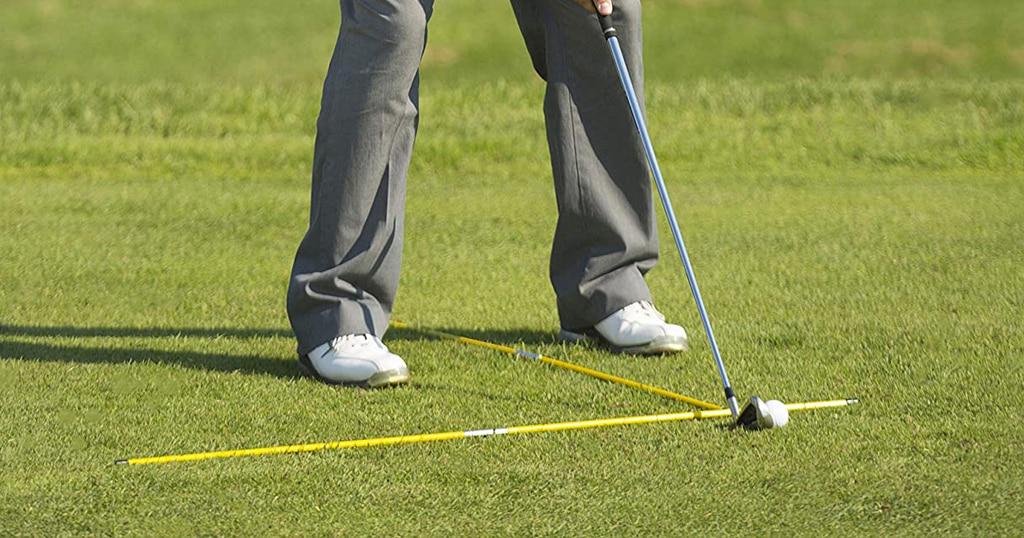
There is a difference between aiming a golf shot at the target and aligning correctly. When we aim we are simply pointing the clubface toward the target. While the clubface is crucial, but you must also align the rest of your body with the target. Even if the rest of your swing is flawless, poor body alignment can result in poor ball striking.
If you feel like you routinely make great swings throughout your rounds of golf, but your results aren't living up to your expectations, poor body alignment could be to fault. Many inexperienced golfers make blunders when taking their stance. Misalignment of your feet, hips, or shoulders can all contribute to you hitting a terrible shot. When the ball swings in the wrong direction, don't immediately blame your swing; there's a chance the error occurred before you ever set the club into motion.
It may appear that aim, and alignment are synonymous, and they certainly do overlap. Still, there are important distinctions to be made. On the most basic level, golf is about consistently hitting your shots as close to the target as possible. With all that can go into it, it's tempting to complicate the game, but it's ultimately a simple fundamental aspect of the game. The more accurately you strike the ball the happier the golfer, and to be accurate, you must be aligned properly before swinging the club.
Learning proper alignment takes practice, however. Nothing in this game comes for free.
There are a few common potential alignment problems in golf. We all make these mistakes, go to the practice range at any event and you will see alignment rods laying on the ground or in the bags of the pros. If their game need improvement in this area likely we do too.
The position of your club face and your body at address must work together to produce the shot you want to hit. The position of the body dictates the clubhead path and the clubface dictates the initial direction of the ball together they dictate the ball flight, straight, curving right to left, or curving left to right. Failure to align both in the manner you desire will result in a failure to hit the target.
The more we can practice the more rapidly we progress. Fortunately, we can practice alignment as part of our regular practice. In fact, if we do not, we will wonder why we are faltering in our practice sessions.
Let’s dispel one of golf’s worst thoughts on ball striking—the parallel line or railroad track analogy. I used this analogy myself till I realized how foolish it was. For most full shots we strike the ball from more than fifty yards. Now let’s suppose that we use the railroad track analogy and we align up a few feet away from the target. Ok now are we really going to be upset if our ball lands a few feet from the hole if we do not align there. Harvey Penick said take dead aim. I am with him forget this analogy. When making shorter shots we want to take advantage of the green contour, so we pick a specific landing spot and aim for that.
Use intermediate targets. Pick targets that are a few yards ahead of your ball position or a few feet and even a few inches. Think about where you want the club to strike the ground (in front of the ball) and where you want the clubhead path to be after you strike the ground.
Remember when on the course, golf course designers are devious. They are not trying to help us but to challenge us. That is why tee boxes are not straight nor are they always level. Pick your target and stay with it. Be confident and align your club and your body at that target.
When you align your feet, align them square to the target. Then you can open the toes or draw the trail foot back if you like. But you know that your initial alignment of the feet was correct. Next check your hips and your shoulders. They should also be initially square to the target.
Do not try and watch professional golfers on TV. Remember the camera angle distorts things. What might look like an open stance might be square or closed. Also, you do not know what is going on in their minds. Maybe they are trying to hit a big cut or a draw and have lined up accordingly.
Locate a mirror. Full-length mirrors are offered at certain driving ranges so you may verify your locations during practice. If your local range has a mirror, occasionally double-check your alignment. Take a posture with the mirror to your right, extending beyond the target line. Once you've found your posture, keep your body in place as you turn your head to check your alignment in the mirror. Suppose you don't have access to mirrors. In that case, you may always ask a buddy to take a picture or video of you during practice that you can use to evaluate your performance.
The body is cooperating. It's tempting to focus on the line formed by your feet at address, but there's much more to body alignment than just foot position. You should also align your knees, hips, and shoulders so that your entire body can swing the club in the appropriate direction.
Now let’s talk about training aids. I suggest that every golfer has a set of alignment rods. But I do not suggest that you go to the golf store or online and buy expensive alignment rods. You can buy a dowel rod at your local hardware store for under $2. Add a can of spray paint for under $5 and now you have a set of alignment rods. If you want to get more expensive rods look to Amazon, they do have a few sets for under $15.